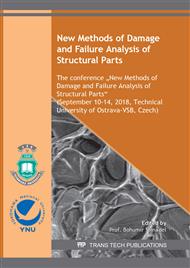p.64
p.70
p.76
p.82
p.89
p.95
p.101
p.107
p.113
Residual Life-Time Evaluation Method Using Instrumented Indentation Test
Abstract:
Predicting the residual life of a structure is an essential issue in structure management. Many researchers have used different methods to predict structure lifetimes, such as the creep rupture test. However, this test is costly and time-consuming, and since it is also destructive, an unused specimen must be tested rather than an actual specimen in use. The instrumented indentation test (IIT), on the other hand, is easier and faster than conventional test methods, most important of all, it is a non-destructive method to obtain mechanical properties that can be performed on the actual structure in use. In this study, we obtained mechanical properties of a SA213-T23 tube material for a thermal power plant degraded for 1~2,000 hours at high temperature. and observed the degradation by analyzing the microstructure. We found a relation between the Larson-Miller Parameter (LMP) and degradation tensile properties considering the temperature and degradation time and suggested a method to predict the residual life by applying a failure criterion. Also, we confirmed that our interaction formula and the residual life are reasonable by comparison with statistical rupture time data from materials that have in fact degraded.
Info:
Periodical:
Pages:
89-94
Citation:
Online since:
July 2019
Authors:
Price:
Сopyright:
© 2019 Trans Tech Publications Ltd. All Rights Reserved
Share:
Citation:


